A compass is one of the most useful tools you can carry with you on a hike. This is especially true for backcountry adventurers who like traveling off the beaten path. Choosing which compass to take with you, however, isn’t as easy as it might seem. Though all compasses work according to the same basic principle, different makes and models have different features. To get the most out of your compass, you should know what your options are.
Quick Navigation:
Why Use A Compass | How To Choose A Compass | Best Compasses
Why Use A Compass?
Compasses point north, but that’s not all they do! Knowing the way you face in relation to the cardinal directions is important when finding your way. Using a compass and a map, you can navigate to landmarks you’d like to see or find your way back to the main trail after a detour. You can make camp knowing which way you’re facing to avoid wind exposure. You can also enjoy the sport of orienteering, which combines trail hiking or trail running with advanced navigation.
But more importantly, having a hiking compass is a safety issue. If you only ever hike well-groomed trails, this might not be a concern— but if you’re serious about backcountry hiking, you need to know how to use a compass.
Your Phone’s Compass Isn’t Enough
In today’s high-tech, highly connected world, it’s easy to treat our phones like external brains. Even for hikers who like to immerse themselves in nature and get away from it all, or backpackers who love to spend time in remote regions, our phones can provide a vital lifeline to GPS if things go wrong.
But what happens if the thing that goes wrong is your phone failing? Maybe you drop it, or the battery dies. You might find yourself cut off from that technology, and in some cases, having the right analog tool and the skill to use it can save your life.
With a compass, you don’t have to worry about the battery or about losing reception. Your compass doesn’t stop working when it gets wet. Your phone’s GPS is great when it works, but if you’re a serious hiker, carrying a good compass that you know how to use is an important part of hiking safety.
Anatomy of a Compass
The most basic feature of a compass is a magnetic needle that points to magnetic north. However, all hiking compasses share three key features. These include some kind of baseplate with arrows in the direction of travel, a rotating bezel (also called the azimuth ring) with degree markings and a bearing line, and a housing unit containing the magnetic needle with orienting lines on the outside. This housing unit usually contains fluid that steadies the needle’s movement, and some compasses have an air bubble in that fluid to act as a level. Some people find these slightly more challenging to read, and so some manufacturers have switched to a separate bubble level next to the main housing. The orienteering lines are used to line your compass up with the north and south markings on your map.
Another important feature of a compass is how it allows you to deal with magnetic declination. Magnetic declination is what determines the amount of difference between magnetic north and geographic north. A compass needle will point towards the magnetic north pole. But this doesn’t mean that a compass always points to geographic north… which is the north that’s marked on your map.
Fluctuations in the Earth’s magnetic field mean that you have to make adjustments to the angle of your bearing to make sure that you’re going in the right direction. Every area has its own magnetic declination. The NOAA has an online calculator for estimating the declination at any longitude/latitude on a specific date, and the local declination is published on all USGS maps.
Compasses allow you to adjust for declination angles in one of two ways. Declination adjustment means that you can use a small tool to turn a screw on the compass’s housing to change the direction of the orienting arrow. This allows you to actually offset the bezel to make it look like the arrow isn’t pointing to magnetic north, but rather to geographic north. Another option is the declination scale. You can use this to orient the compass in an area with known declination, or to add or subtract the known declination wherever you’re traveling. This requires more work but may be preferable for people who don’t want to deal with resetting the declination adjustment afterward or worry about fiddling with it in cold temperatures where manual dexterity is lower.
Lensatic Compasses
While most modern compasses are baseplate models, some hikers prefer to use lensatic compasses. These compasses, like those used by the US military, incorporate a lens over the compass dial to help you read it. They also have a top cover that flips open. This cover incorporates a sighting wire, which is a crosshair embedded in a clear circle or oval within the top of the cover. More advanced sighting wires may also have small orienting marks next to them. A sighting wire provides highly accurate wayfinding. While these can be more challenging to use with a map, they are extremely useful for navigating off-trail.
Additional Features
Other features that a compass may have include:
- Clinometer: This tool allows you to measure elevation, and can be helpful for mountaineering, backcountry skiing, or hiking in places where you may be concerned with avalanche hazards
- Global needles: Most compasses are specific to one of the seven compass zones. A global needle is more expensive but works no matter where you are. If you’re a global traveler, you might appreciate this feature
- Luminescent indicators: Luminescent markings on the bezel, or even an entire luminous bezel, will let you take readings at night or in low light situations
- Magnifier lens: Some compasses have a built-in magnifier housed in the baseplate or a larger magnifying loupe that swings out on an attached pivot point. These make it easier to read small features on maps
- Map scale rulers: All compasses will have at least one or two map scale rulers, but for orienteers, compasses with several different rulers may be preferable. You can use these rulers to measure your route and determine distance
- Mirrors: Mirrors can be helpful for precise navigation towards a distant landmark. Some mirrors have sighting notches, which makes this even easier. In a pinch, they can also be used to angle light for emergency signaling
- Orienteering arrow: Some compasses have an orienteering arrow marked on the floor of the housing. This rotates with the bezel when it’s turned, and is used to orient a compass to a map more accurately
- Silicone feet: These can help stop your compass from sliding around and make it easier to situate it on your map
- Slope cards: These are reference guides to how slope is portrayed on topographic maps. They are very useful for helping identify avalanche hazards and are somewhat easier to use than a clinometer
- Whistles: Some compasses have a built-in emergency whistle to signal other hikers. This safety feature means that you wouldn’t have to keep a whistle on hand, which could be annoying to try to find in your pack in case of an emergency
So which of these features are necessary? That depends on your needs! If you’re an international traveler, a global needle is a great feature to look for. Orienteering arrows are extremely useful and make it much easier to navigate using a map. We also really like it when compasses have mirrors with sighting notches because they make it much easier to customize your hike and get back to your route after exciting detours to interesting landmarks.
How to Choose a Compass
Just like any other gear choice, there are lots of things to consider when buying a compass. One feature you likely won’t have to worry much about is weight. All compasses are relatively small, light pieces of gear; they don’t take up a lot of space and they won’t weigh you down. Some features you should consider include:
Price
Most compasses aren’t all that expensive. Some of the best models available cost less than $50. Models with global needles will cost more, but even a durable, global-needle model is unlikely to be much more than $100. A higher price might not mean better quality; it might just mean more features, some of which you might find unnecessary.
Durability
Durability is something many hikers their top priority for a compass. This makes a lot of sense when you think about it— compasses are small and likely to get tossed around in your bag. If the compass’s housing cracks or breaks in your bag, it’s not particularly easy to use.
Also, be aware that some compasses may claim to be more durable than they actually are. If you see the word “milspec,” be sure to read the reviews to check that you’re not getting a knockoff. Military spec compasses are tough as old boots, and unscrupulous sellers know that it’s a major selling point.
Luminosity
Whether you only want luminous markings or an entire glowing dial, luminosity can make a huge difference in the early mornings or late evenings. This feature can make your compass-using experience much easier. You’ll be able to take a reading or get your bearings without sacrificing your eyes’ adjustment to the dark. If you hike in the twilight hours, the presence or absence of this key feature might make your decision much easier.
Compass Cases
Some compasses come with nice, heavy-duty cases. If yours doesn’t, you should consider a dedicated case to keep your compass’s surface free from scratches and to keep the needle protected from electronic interference. While most consumer electronics don’t produce a strong enough current to demagnetize a compass needle with limited exposure, you might not want to take the risk if you are relying on your compass for orienteering. Also, even if short-term exposure doesn’t cause issues, long-term exposure may. Store your compass away from electronics for the best results.
Compass Recommendations
There are lots of great compasses out there, but first we want to make sure that you know: if it’s on a keychain, don’t use it for hiking! Keychain compasses might be cute and decorative, but they’re not much more than that. You can’t navigate or use a map with what’s essentially a toy.
You also want to make sure that you get a hiking compass, not a diving or marine compass. Wrist-mounted marine compasses will work on land, but they won’t have the key features you need for navigation in the open air. Some orienteering compasses are also not ideal for hiking. Thumb compasses are small and worn on the thumb. They have very few features and are primarily used to make small adjustments to one’s path. These are great for orienteering races in city parks and other short courses, but not so well-suited for backcountry use.
Generally speaking, compasses made by Brunton, Cammenga, Silva, and Suunto are going to be durable, high quality products. While there are many great manufacturers, these brands have well-earned reputations for the accuracy and durability of their equipment.
Best Compasses Under $50
These compass choices are great for hikers of any skill level who prefer to hike in North America. These compasses are all calibrated to Zone 1, which includes all of the United States and Canada.
Brunton Nexus 7DNL Compass
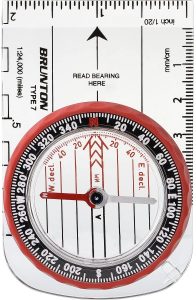 You’ll want to keep this one on a lanyard. At barely three inches long and weighing under an ounce, the Brunton Nexus 7NDL is a small but mighty compass. This pint-sized powerhouse is a great little tool at a very affordable price.
You’ll want to keep this one on a lanyard. At barely three inches long and weighing under an ounce, the Brunton Nexus 7NDL is a small but mighty compass. This pint-sized powerhouse is a great little tool at a very affordable price.
Price: $14-$15
Best Features: Compact size, map scale, imperial and metric rulers, small profile.
Silva Explorer Pro Compass
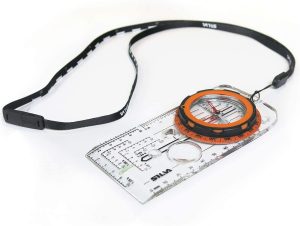 Silva’s Explorer Pro is a great model, especially for orienteering. Silva’s products are known for their easily-read markings, and the Explorer Pro is no exception. It’s easy to use during the day, and its luminous markings can be seen for up to four hours after being exposed to light.
Silva’s Explorer Pro is a great model, especially for orienteering. Silva’s products are known for their easily-read markings, and the Explorer Pro is no exception. It’s easy to use during the day, and its luminous markings can be seen for up to four hours after being exposed to light.
Price: $34.49
Best Features: Slope card, DryFlex rubber grip, declination adjustment, luminous markings, magnifying lens
Suunto MC-2 Mirror Compass
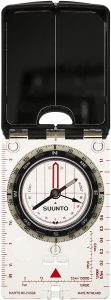
SUUNTO MC-2 Mirror Compass
The Suunto MC-2 Mirror compass is a popular model with several useful features. Suunto is known for the precision of their instruments, as well as their eighty-year legacy of toughness and reliability.
Price: $39
Best Features: Mirror, sighting hole and notch for accurate bearings, declination adjustment tool, clinometer, luminescent markings
Best Compasses Over $50
These compasses all come fully loaded with features to improve your outdoor adventures. We’ve recommended two models with global needles and one lensatic model we picked for its awesome durability.
Suunto MC-2 G Mirror Compass
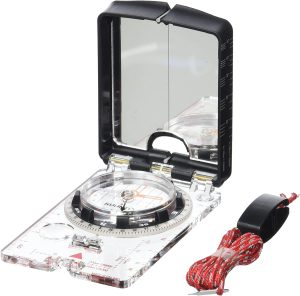 Virtually identical to the esteemed MC-2 Mirror Compass, the MC-2 G has all the handy features of the MC-2, plus a global needle. A savvy hiker will shop around if they’re interested in this model because while it normally retails for $95, it can often be found new for as little as about $55.
Virtually identical to the esteemed MC-2 Mirror Compass, the MC-2 G has all the handy features of the MC-2, plus a global needle. A savvy hiker will shop around if they’re interested in this model because while it normally retails for $95, it can often be found new for as little as about $55.
Price: $54.55 on Amazon
Best Features: Mirror, sighting hole and notch for accurate bearings, declination adjustment tool, clinometer, luminescent markings, global needle
Brunton Tru-Arc 15 Compass
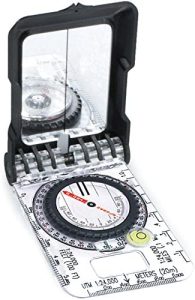 Brunton got their start making compasses for geologists and foresters, and their current product lines keep these professions’ need for reliable accuracy in mind. Their compasses are known for their magnetic interference resistance, and the Tru-Arc 15’s global needle keeps its accuracy throughout the world.
Brunton got their start making compasses for geologists and foresters, and their current product lines keep these professions’ need for reliable accuracy in mind. Their compasses are known for their magnetic interference resistance, and the Tru-Arc 15’s global needle keeps its accuracy throughout the world.
Price: $59.99
Best Features: Global needle, toolless declension adjustment, map magnifier, magnified readout, separate bubble level, sighting mirror
Cammenga H3 Tritium Lensatic Compass
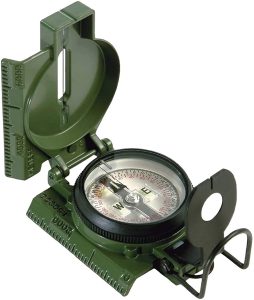 Cammenga’s lensatic compasses are unique for two reasons. First, Cammenga’s models use a copper induction ring instead of liquid to steady their needles’ movements, which means that their compasses can be used at temperatures ranging from -50ºF to 150ºF. Additionally, they use self-lighting tritium for their luminescent markings, which means steady illumination for up to 12 years without having to charge the paint via light exposure.
Cammenga’s lensatic compasses are unique for two reasons. First, Cammenga’s models use a copper induction ring instead of liquid to steady their needles’ movements, which means that their compasses can be used at temperatures ranging from -50ºF to 150ºF. Additionally, they use self-lighting tritium for their luminescent markings, which means steady illumination for up to 12 years without having to charge the paint via light exposure.
Price: $100
Best Features: Sandproof, shockproof, and waterproof, rugged metal housing, tritium micro-lights, accurate guide wire
Max DesMarais is the founder of hikingandfishing.com. He has a passion for the outdoors and making outdoor education and adventure more accessible. Max is a published author for various outdoor adventure, travel, and marketing websites. He is an experienced hiker, backpacker, fly fisherman, backcountry skier, trail runner, and spends his free time in the outdoors. These adventures allow him to test gear, learn new skills, and experience new places so that he can educate others. Max grew up hiking all around New Hampshire and New England. He became obsessed with the New Hampshire mountains, and the NH 48, where he guided hikes and trail runs in the White Mountains. Since moving out west, Max has continued climbed all of the Colorado 14ers, is always testing gear, learning skills, gaining experience, and building his endurance for outdoor sports. You can read more about his experience here: hikingandfishing/about
